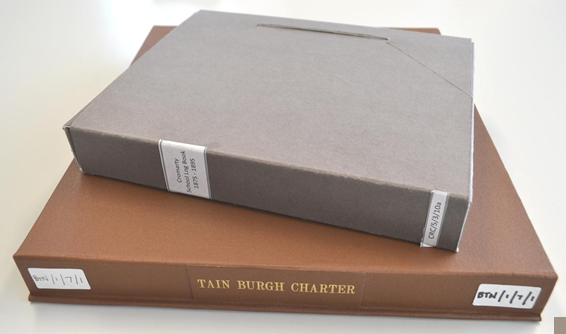Packaging advice
Using inappropriate materials to package items in your personal archive will cause long term damage. Acidity and discolouration migrates from poor quality papers and will stain and degrade those next to them. Proper packaging will offer valuable protection for your archive and significantly enhance its longevity. Consult the suppliers list for sources of suitable materials.
Envelopes and Boxes
Avoid – Poor quality papers such as newspaper, brown paper, recycled paper. These are often made of wood pulp with a high lignin content which causes the paper to become acidic, discoloured and brittle over time. These symptoms are transferred to the documents inside.
Alternative – Primary packaging (that next to the documents) is the most important. Use archival envelopes, folders or wrapping paper. Secure with a soft, unbleached cotton tape.
Avoid – Cardboard, wood or metal boxes.
Alternative – Box preferably in an archival box, but any box is better than none.
Clear Plastic Sleeves
Avoid – PVC enclosures such as A4 sleeves available from stationers. They emit acids harmful to paper and degrade over time.
Alternative – Use archival polyester sleeves for single sheet items of any kind (except where ink is friable). A variety of sizes and formats can be purchased. Each side of a document is visible, weak or damaged paper is supported and it is possible to copy or scan through the sleeve.
Photographs
Avoid – commercial albums, particularly self adhesive, also plastic sleeves. These materials are harmful in the long term for photographs.
Alternative – mount using photo corners in an archival album. Sleeve in “silver safe” envelopes, low in sulphur or non-static archival polyester or polypropolene pockets.
Avoid – unnecessary handling of prints and negatives as oils from the fingers can have a detrimental effect.
Alternative – use cotton gloves or handle just at the edges. Sleeve photographs for consultation in transparent archival polyester. Make a copy set for frequent viewing.
Fastening Documents Together
Avoid – fastening or tying items if at all possible. Metal in the form of paper clips, staples etc. will stain as well as physically damage paper. Also avoid string or coloured tapes for tying bundles.
Alternative – If a paper clip is essential, use solid brass. Protect the document by folding a good quality paper strip to support the brass paper clip. Use a wide, soft, unbleached cotton tape for tying bundles if required. Again protect the bundle by using a protective paper round the sides or a four flap folder. It is preferable however to use folders, envelopes or boxes to contain material and tie the packaging not the documents.
Mounting and Framing
Avoid – framing precious items if possible. Pigments and photographs can fade, paper can discolour.
Alternative – frame a duplicate, e.g. scan or photocopy.
Avoid – contact with standard type mount boards and back boards. Acidity and discolouration will migrate into and stain paper.
Alternative – use conservation standard mount board (100% rag is the best quality but some e.g. buffered, lignin free boards are available) in front of and behind the item. Alternatively, use an archival barrier (e.g. archival paper or polyester) between the item and a poorer quality mount.
Avoid – sticking items into mounts with unsuitable tapes, e.g. sellotape.
Alternative – use or request use of archival framing tape or ask a conservator to do it for you.
Avoid – direct contact with the glass, which does not allow adequate ventilation to an item. Also, problems can result from condensation.
Alternative – use a window mount to isolate from the glass. Or use strips of archival mount as spacers underneath the lip of the frame.
Avoid – clip frames, which do not protect pictures from dust, fluctuations in temperature and humidity and small insects.
Alternative – use sealed frames, seal at the back and seal the glass into the frame with gummed tape.
Labelling Your Collection
Avoid – any adhesive tape or label on any item. The adhesive will eventually stain the paper and possibly become unstuck.
Alternative – Label your packaging instead, pencil for paper, indelible pen for archival polyester. If you must label your document, use a soft pencil.
Avoid – paper inserts or “Post-its” to mark pages in books. Acidity and staining can migrate from a poor quality paper. Too many slips will distort the text block.
Alternative – mark pages either with archival paper or make a note of the page separately.
UK Suppliers of Conservation Materials
Terminology regarding the quality of paper and card can be misleading. Terms such as “acid-free” may indeed mean that the paper is pH 7 (neutral) but does not give any information regarding the content of the paper or the amount of buffer included to resist acidity in the long term. Quality materials may be described as; lignin-free, buffered (though not suitable for photographs), pH over 8, high alpha-cellulose content.
Cost is also a useful guide, the more expensive materials are likely to be better quality. It is preferable to have higher grade packaging in contact with your documents (e.g. envelopes) while secondary packaging (e.g. box) may then be more economical.
Below are some Suppliers of Conservation Materials
The Highland Archive Service is not responsible for the content of internet sites other than its own.

